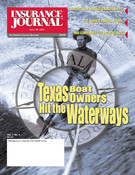With summer just around the corner; nearby lakes and rivers are being overrun with boats and personal watercraft. The boating and watercraft business in the United States has grown into a major industry, and it shows no signs of slowing.
More than 76 million Americans take to the water each year, according to figures released by the National Marine Manufacturers Association. And they spend more than $23 billion annually on marine products and services. While boating has always been a fixture of the American recreation scene, gains in the last 40 years in both motor and boat design have pushed the number of people hitting the waterways to new heights. Today more than 16 million boats are put to use, and one out of every three Americans takes part in some form of boating each year.
Texas, which sports some 80,000 miles of rivers and streams, including 41 major waterways, ranks among the top five water sports states in the country.
Taking all precautions
In Texas, one of the first steps to safe boating is making sure the craft is properly registered. Since 1997, all vessels on public waterways in the Lone Star State have been required to have current registration, whether moving, docked, moored or stored.
A second step, of course, is ensuring that the craft has the proper insurance. While opinions vary on what may constitute “proper,” most insurers agree there are some common features underwriters look for whether covering a pleasure craft or a PWC.
“We check the age of the operators, check DMV records, the value and speed of the boat, etc.,” said Dane West, a personal lines underwriter with Burns & Wilcox in Houston. “Obviously you don’t want an 18-year-old or anyone else for that matter operating a craft with a bunch of DUIs on their record.” West notes that boating courses are strongly recommended by himself or anyone else selling coverage.
The Texas Parks & Wildlife encourages boaters in Texas to take part in their boater education classes. Instruction is recommended for all boaters. Texas law requires certification for some operators. Many insurance companies in the state offer discounts of nearly 20 percent for policyholders who successfully complete an approved course. Many insurance experts agree that boating education can prevent a day on the lake or river from becoming a nightmare.
Where the craft is stored and where it is used can also factor into the final price. The cost to insure a boat is usually higher in coastal waters as opposed to inland and rivers—especially in locales vulnerable to hurricanes—and even higher if the boat is used year-round.
PWC market rises
£One of the most popular ways to take to the water is on a personal watercraft. This pastime represents a market that has ballooned in the last couple of decades.
The Personal Watercraft Industry Association (PWIA) reports that based on recent industry research, the normal purchaser of a new PWC is about 41 years old with a household income of just over $95,000. Statistics indicate that roughly 85 percent are male, 71 percent are married, and 69 percent have owned a powerboat before purchasing a PWC.
While some PWC models can hit 60 mph or more, recent studies indicate that most owners do not race or make aggressive moves. More than 80 percent are simply riding with family and friends for short ventures, towing skiers, discovering new areas and entertaining friends. Not even one percent of those studied indicated that they use their craft for racing purposes.
When PWC accidents do occur, however, they can be severe. According to U.S. Coast Guard (USCG) figures, nearly 50 percent of all boating accidents are PWC-related. Almost half of those lead to injuries; some 75 percent of severe, collision-related PWC injuries occur with two or more PWCs; and deaths related to PWC accidents generally are from blunt trauma, such as a hit to the head, not from drowning.
Data indicate that alcohol often plays a role in waterway accidents. Statistics released through the USCG to the Insurance Information Institute show that over the last decade, accidents related to alcohol use by recreational boat users accounted for 7.5 percent of all cumulative boating mishaps. Even more frightening to those using the waterways is that eight out of every 10 victims in fatal boating accidents were not wearing life jackets. It is estimated that tying on a life jacket may have saved more than 500 boaters’ lives.
On a positive note for those using recreational boating equipment, the USCG reports that recreational boating fatalities are decreasing. The study notes that fatalities have dropped from more than 800 five years ago, to 678 fatalities thru mid-December of 2000.
Meeting boaters’ needs
When it comes to PWCs, the majority of Jet Ski, Sea-Doo, and other jet-powered craft aren’t covered by homeowners’ policies.
Virginia-based BoatU.S. Marine Insurance, with offices across the country, including three in Texas, gives boat owners one solution with a PWC program underwritten by CNA or Seaworthy Insurance Company. Aimed at the safe driver, the PWC policy presents broad coverage, a complete package policy and 24-hour emergency assistance.
BoatU.S. has four different policies directed towards the need of boaters, ranging from yachts to personal watercraft. Coverage is available in all 50 states, along with Canada, Mexico, the Bahamas and Bermuda.
Becky Squires, spokeswoman for BoatU.S., points out that personal watercraft insurance is pretty standard to write. “We’ve been underwriting this type of insurance since 1994,” Squires said. “Personal watercraft underwriting is a small portion of the $6-billion underwriting we do. In most cases, most people aren’t aware that personal watercraft insurance is not covered on homeowner’s insurance.”
Sales of personal watercraft are basically flat at the moment, according to Squires. “I don’t see any major changes in the underwriting market for PWCs in the near future,” Squires said. “One thing people need to know is that the rate of theft of PWCs is higher than any other boat, due to the fact that they are smaller and easier to move around.”
Looking for coverage
Eric Arthur, an underwriter with Austin Surplus Lines Agency, noted that the personal watercraft market is on the rise. “Our program allows for a stand-alone PWC policy, or we can group together watercraft on one policy for families that have multiple watercraft,” Arthur said. “The market is certainly increasing. It seems like everyone has a jet ski these days. The problem is finding a market for the younger operators.”
According to Arthur, his office receives a substantial number of calls from people looking for PWC coverage for the younger set. “I get a lot of calls asking if the 13- to 14-year-old will be covered,” Arthur commented. “We won’t write anyone under 16.”
A number of factors are considered in coming up with the right policy for each individual. “Factors to consider are: driving record, experience on the water, safety courses taken, age of the craft, horsepower, speed, loss record, etc.,” Arthur said. “The key hazards or causes of loss associated with PWC include collision and running aground.”
ASLA charges $4 per $100 of value on the jet ski, with liability ranges depending on the limit. “A $7,000 jet ski with a combined single limit of $100,000 would have a premium of around $450,” Arthur added. The property damage deductible is $250 with none for liability.
Another common question is whether coverage is offered in transporting a PWC to a lake or river. “We can offer coverage for trailer, but it is not mandatory,” Arthur said. He added that auto policies in most cases should cover transporting a PWC.
As Arthur points out, the PWC insurance business can move around like any other product. “For us the line has been profitable, but like any other areas of insurance, it all depends on your underwriting.”
Topics Texas Underwriting
Was this article valuable?
Here are more articles you may enjoy.


 A $29 Billion Weed Market Fights to Diversify Amid Legal Hurdles
A $29 Billion Weed Market Fights to Diversify Amid Legal Hurdles  GEICO Tops Progressive With Higher J.D. Power Scores
GEICO Tops Progressive With Higher J.D. Power Scores  Home Insurance at $10,000 a Year Shows California Buyers’ Pain
Home Insurance at $10,000 a Year Shows California Buyers’ Pain  Farmers Adjusters Cry Foul Over Workloads, Claims Handling in Letter to Regulators
Farmers Adjusters Cry Foul Over Workloads, Claims Handling in Letter to Regulators 


